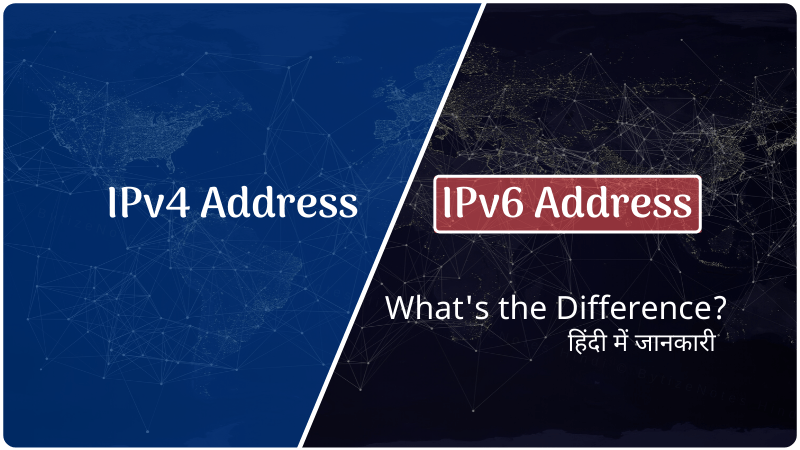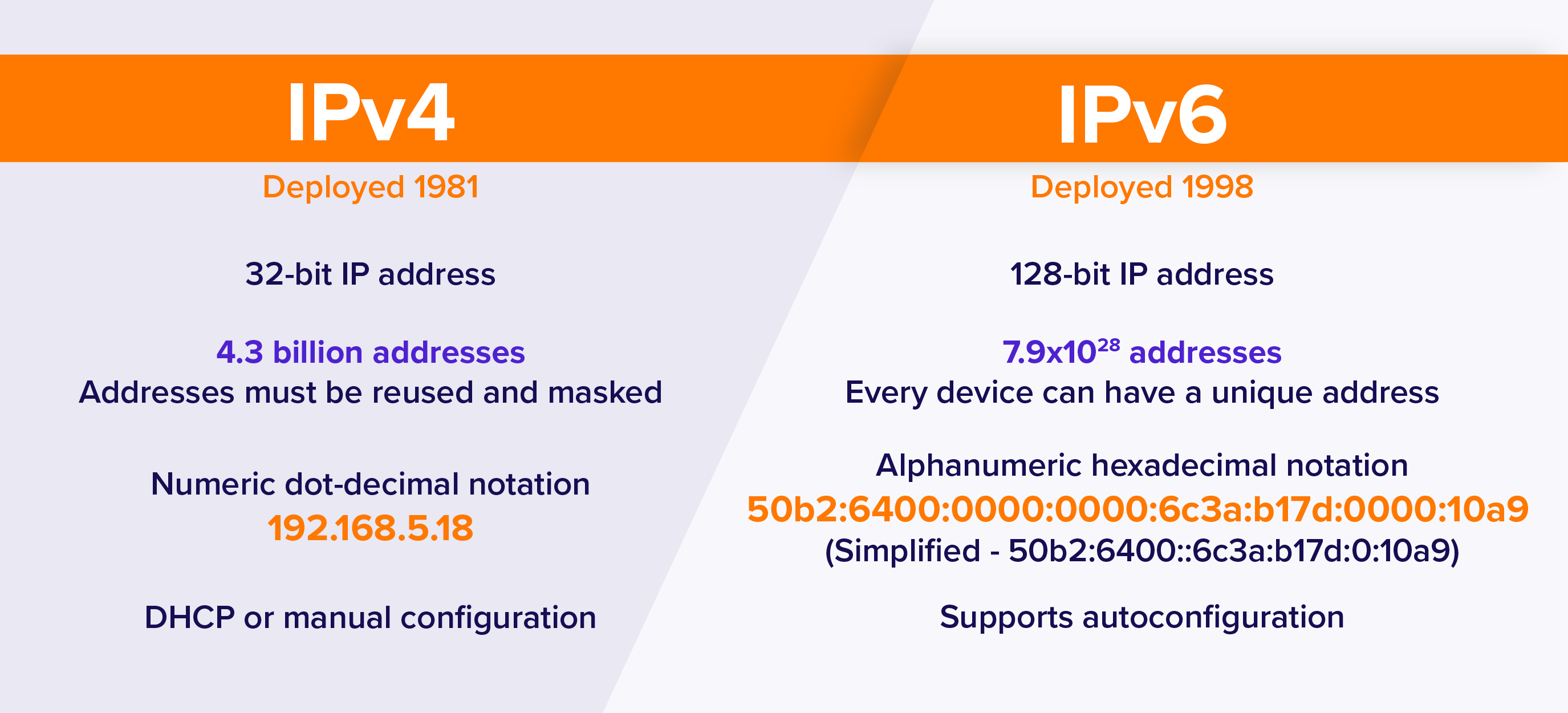आप Computer Network में IP Address क्या होता है? इसके बारे में जान चुके हैं, तो चलिए अब हम जानते हैं कि IPv4 और IPv6 में क्या difference हैं?
IP Address हिंदी में:
यह आपके Computer/ System को Network की मदद से पुरे दुनिया में Other device से Coneect करने में मदद करता है। किसी IP Address में, numbers और characters हो सकते है।
IP Address का उदाहरण: 192.405.24.108,
IP Address Versions: IPv4 और IPv6

IP Address के दो Versions हैं: IPv4 और IPv6, आइए इन दोनों के बीच अन्तर जानने से पहले हम IPv4 Addresses और IPv6 Addresses के बारे में नीचे जानते हैं:-
What is IPv4 in Hindi
IPv4 IP का पहला Version था। यह 1983 में पहली बार ARPANET द्वारा इस्तेमाल किया गया था । आज IPv4 सबसे व्यापक रूप से इस्तेमाल किया जाने वाला IP Version है। इसका उपयोग Addressing System का उपयोग करके नेटवर्क पर Devices की पहचान करने के लिए किया जाता है।
IPv4 32-Bit का होता है। IP Version 4 से लगभग 4 बिलियन से अधिक Network Device को IP Address Provide की जा सकती है। IP Version 4 को अब तक प्राथमिक इंटरनेट प्रोटोकॉल माना जाता है और यह Version इंटरनेट में Connected डिवाइस पर लगभग 94% इस्तेमाल किया जाता है।
Features of IPv4 (Internet Protocol Version 4):
- Connectionless Protocol
- Allow creating a simple virtual communication layer over diversified devices
- It requires less memory, and ease of remembering addresses
- Already supported protocol by millions of devices
- Offers video libraries and conferences
यह भी पढ़ें:
What is IPv6 in Hindi
सभी डिवाइस जो इंटरनेट से Connected हैं उनके पास एक Unique IP Address होता है और आज के समय में लगभग सारे लोग Internet इस्तेमाल करते है और आने वाले समय में इसकी संख्या और बढ़ेगी जिसका अर्थ है कि इंटरनेट के लिए अरबों IP Address की आवश्यकता होगी और जैसा की हम जानते है की P Version 4 से केवल 4 बिलियन तक ही Network Device को IP Address दी जा सकती है। इस कमी को पूरा करने के लिए IPv6 को Develop किया गया है।
यह (IP) इंटरनेट प्रोटोकॉल का सबसे नवीनतम संस्करण है। इंटरनेट इंजीनियर टास्कफोर्स ने इसे 1994 की शुरुआत में शुरू किया था। और अधिक इंटरनेट IP Address की आवश्यकता को पूरा करने के लिए यह नया IP Version को Deployed किया जा रहा है। इसका उद्देश्य उन कमियों को पूरा करना था जो IPv4 में थी।
IPv6 128 Bit का होता है और इससे लगभग 340 Undecillion Network Devices को Unique IP Address Provide किया जा सकता है। IPv6 को इंटरनेट प्रोटोकॉल की अगली पीढ़ी भी कहा जाता है।
Features of IPv6 (Internet Protocol Version 6):
- Hierarchical addressing and routing infrastructure
- Stateful and Stateless configuration
- Support for quality of service (QoS)
- An ideal protocol for neighboring node interaction
यह भी पढ़ें:
तो अभी तक हम ने जाना कि IPv4 & IPv6 IP Address क्या हैं?, आइए अब IPv4 और IPv6 के बीच अंतर के बारे में जानते हैं।
Difference between IPv4 and IPv6 IP Address

जैसा कि हमने अभी तक जाना IPv4 और IPv6 दोनों ही एक प्रकार के IP Address हैं। IPv4, IP Address में 32-bit, जबकि IPv6 में 128 bit होते हैं। IPv4 Address को (.) से अलग किया जाता है जबकि IPv6 Address को (:) द्वारा अलग किया जाता है।
दोनों प्रकार के IP Address का उपयोग Network और उनसे जुड़ी हुई Machine की पहचान करने के लिए किया जाता है। आइए इसे अच्छे से समझने के लिए हम दोनों IP Address, IPv4 और IPv6 के बीच अंतर को एक Comparison Chart को देखते हैं:-
IPv4 और IPv6 के बीच अंतर (Comparison Chart between IPv4 & IPv6)
| Basis of comparison | IPv4 protocol | IPv6 protocol |
|---|---|---|
| Address Configuration | Supports Manual and DHCP configuration. | Supports Auto-configuration and renumbering |
| End-to-end connection integrity | Unachievable | Achievable |
| Address Space | It can generate 4.29 x 109 addresses. | It can produce quite a large number of addresses, i.e., 3.4 x 1038. |
| Security features | Security is dependent on the application | IPSEC is inbuilt in the IPv6 protocol |
| Address length | 32 bits (4 bytes) | 128 bits (16 bytes) |
| Address Representation | In decimal | In hexadecimal |
| Fragmentation performed by | Sender and forwarding routers | Only by the sender |
| Packet flow identification | Not available | Available and uses flow label field in the header |
| Checksum Field | Available | Not available |
| Message Transmission Scheme | Broadcasting | Multicasting and Anycasting |
| Encryption and Authentication | Not Provided | Provided |
Advantages of IPv6 over IPv4? (IPv6, IPv4 से बेहतर क्यों?)
IPv6 में एक feature है, जिसे autoconfiguration कहा जाता है, जो किसी device को IPv6 address को generate करने की अनुमति देता है, जैसे ही device नेटवर्क में आता है।
जबकि IPv4 में, उपकरणों को जोड़ने के लिए manual process को पूरा करना पड़ता है। IPv6, devices को एक साथ कई नेटवर्क से जुड़े रहने की अनुमति देता है।
लेकिन, क्या IPv6, IPv4 से बेहतर है?
- Self-Configuration: IPv6 devices, network में आते ही independently auto-configure हो सकते हैं। इसमें IP address assign करना और device numbering आती हैं।
- Efficient Routing: यह Routing को अधिक efficient बनाता है।
- Efficient Packet Processing: IPv4 की तरह, IPv6 में कोई IP-level checksum नहीं होता है, इसलिए Checksum को हर Router hop* पर Recalculate करने की आवश्यकता नहीं होती।
- More Security: IPSec security, जो Network में confidentiality, authentication और data integrity देती है, को IPv6 में बढाया गया है।
*Hop, एक Computer networking में उपयोग किया जाने वाला term(शब्द) है जो एक Router के number को बताता हैं, जब कोई Data packet अपने Source से Destiniation के लिए जाता है।
यह भी पढ़ें:
- Types of Computer Networks in Hindi
- What is Artificial Intelligence (AI) क्या है?
- Asynchronous Transfer Mode kya hai?
आज हमने “IPv4 and IPv6 in Hindi” के बारे में जाना, आप इस को अपने दोस्तों के साथ ज़रुर शेयर करे। अगर आप IPv4 और IPv6 से जुड़ा हुआ कोई सवाल पूछना चाहते है.? या हमे कोई जानकारी देना हो.. तो आप Comment कर सकते है।
